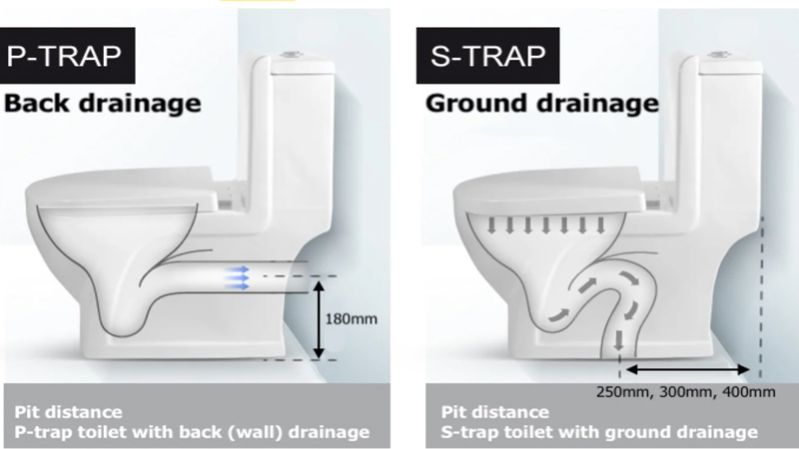
Understanding the difference between P-Trap and S-Trap
P-traps and S-traps are plumbing devices that create a water seal to prevent sewer gases from entering a building, but they differ in shape and function, with S-traps being less common and prone to siphoning issues.
Understanding the Difference Between P-Trap and S-Trap
When it comes to plumbing, especially in the context of bathroom and kitchen drains, understanding the types of traps used is essential for maintaining a functional and efficient drainage system. Two common types of traps you’ll encounter are the P-trap and the S-trap. While both serve the same basic purpose—preventing foul odors from entering your living space—there are notable differences between the two in terms of design, application, and functionality.
In this blog, we’ll break down the key differences between P-traps and S-traps to help you make more informed decisions when working with plumbing systems.
---
What Is a Trap?
Before diving into the specifics of P-traps and S-traps, let’s first understand what a "trap" is in plumbing.
A trap is a plumbing device that holds a small amount of water to create a barrier between the drain line and the living space. This water barrier prevents gases and odors from entering the home from the sewer or septic system. Traps are an essential part of any plumbing system, helping to maintain hygiene and air quality.
Now that we know what a trap does, let’s explore the two main types: P-trap and S-trap.
---
P-Trap: The Standard Plumbing Solution
The P-trap is one of the most widely used plumbing traps in modern plumbing systems. Its name comes from the shape of the pipe, which looks like the letter “P” when viewed from the side. It’s often found under sinks, bathtubs, and showers, as well as in some toilets.
Key Features of a P-Trap:
1. Design: The P-trap has a distinct U-shaped bend in the pipe, followed by a horizontal section that leads to the drain line. This shape is designed to trap a small amount of water, creating a seal that prevents sewer gases from flowing back into the home.
2. Efficiency: The P-trap works by filling the bend with water, which blocks the flow of odors or gases into the home. As the water sits in the trap, it also keeps debris and solids from backing up into the system.
3. Safety and Regulation: P-traps are the industry standard and are widely used in plumbing codes. They’re required for almost all drains in homes, including sinks, showers, and bathtubs. P-traps are more reliable than S-traps in preventing sewer gases from escaping into living spaces.
4. Maintenance: Because of its simple and reliable design, the P-trap is easy to maintain. It can be cleaned or replaced if needed, making it a popular choice for DIY plumbers.
---
S-Trap: The Outdated Plumbing Solution
The S-trap, as the name suggests, has a design that resembles the letter "S." While it functions similarly to the P-trap in that it holds water to block gases, it is no longer commonly used in modern plumbing systems due to potential issues.
Key Features of an S-Trap:
1. Design: The S-trap is shaped like an "S," with two bends in the pipe. One bend is typically located near the drain, and the other is near the trap’s exit to the drain line. It also creates a water seal, but with a more complex shape compared to the P-trap.
2. Flaw in Function: One of the main issues with S-traps is that they can be prone to siphoning. When a large amount of water is quickly drained (for example, from a sink or bathtub), it can cause the water seal in the trap to be sucked out. This creates a vacuum that can allow sewer gases to escape into the living space.
3. Obsolescence: Due to the siphoning issue, S-traps are no longer allowed in many modern plumbing codes. They have been largely replaced by the more reliable P-trap, which doesn’t have this problem. S-traps can still be found in older plumbing systems, but it is recommended to replace them with P-traps to ensure better safety and functionality.
4. Maintenance: If you have an S-trap in your home, it may require more frequent maintenance due to the risk of the water seal being disturbed. Over time, S-traps can become less effective and may even allow foul smells to enter the home.
---
Why Is the P-Trap Preferred Over the S-Trap?
1. Prevention of Siphoning: As mentioned earlier, the primary disadvantage of an S-trap is its tendency to siphon the water seal, which can result in unpleasant odors escaping into your home. The P-trap, with its one-way design, prevents this issue.
2. Durability and Longevity: The P-trap is designed to last longer and perform better in most situations. It’s far less likely to experience issues such as siphoning or clogging, and it’s easier to clean and maintain over time.
3. Compliance with Plumbing Codes: Due to their reliability, P-traps are the standard in most modern plumbing systems. In fact, they are required by plumbing codes in many places, making them the go-to solution for both residential and commercial plumbing.
---
Conclusion: P-Trap vs. S-Trap
While both the P-trap and S-trap serve the same purpose of preventing sewer gases from entering your home, the P-trap is the preferred option for modern plumbing systems. Its design prevents siphoning and offers greater reliability and longevity, making it the more effective and code-compliant choice.
If you're planning a plumbing installation or renovation, opting for a P-trap is highly recommended. If you happen to live in an older home with an S-trap, it’s a good idea to have it replaced with a P-trap to ensure optimal function and safety.
Understanding the differences between P-traps and S-traps will help you make better decisions for your home’s plumbing system and ensure you have a safe, efficient drainage system in place.

